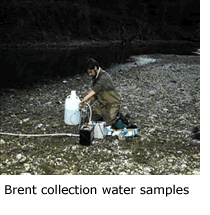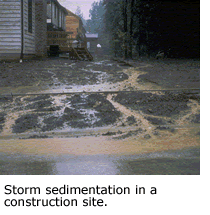Environment Research
As the population continues to grow, the impact humans have on the environment has increased. With increasing urbanization, there are greater numbers of human- natural environment interactions that have to be resolved in order for sustainable development to occur. Many of our environmental projects address the impacts of human development and land use change on the environment, especially at the watershed scale. Often, these research projects address real problems, and are therefore utilized by other institutions to aid them in efficiently resolving the issue. Our rapidly changing environment constantly provides us with interesting and challenging research projects!
CURRENT RESEARCH
Watershed Influences on Terrestrial Organic Carbon Export
|
Assessing the Historical Impacts of Landscape Transformation on Water Fluxes in the Great Lakes Basin for Environemental Monitoring and AssessmentApproximately 18% of the world’s freshwater supply is contained in the Laurentian Great Lakes providing drinking water to over 40 million people. As a significant part of the larger Great Lakes drainage basin, one of the most intensively exploited freshwater systems worldwide, the Muskegon River watershed can be used to develop a methodology for investigating how human modifications of landscape affect water cycling from ecosystem to regional scales through the linkage of models that characterize land use change and water fluxes. Alison Goss is investigating this issue through linking recreations of historical and future land use scenarios (“backcasts” and “forecasts” covering from 1900 to 2050) to a Variable Infiltration Capacity (VIC) model that predicts water and energy fluxes within an area of interest. Integrating models that address land use change, hydrology fluctuations, as well as climate change scenarios enable the assessment of future consequences of land use change and climate scenarios on water resources, and consequently, to address policy questions related to the sustainability of current resources.
|
Construction Site Erosion Control (1991-Present) |

 The effects on watersheds by nonpoint source pollution from a variety of land uses has been an issue of growing concern in the last decade. This project focuses on trying to determine how upland processes influence organic carbon dynamics in terrestrial systems. Brent Dalzell and Dr. Tim Filley are applying molecular and stable isotope techniques to study how hydrology, seasonality, land management, and watershed geography can influence the nature and extent of organic carbon exported from an agricultural watershed. Preliminary results indicate that the quantity, quality, and source of terrestrial organic matter exported from the study area (Big Pine Creek watershed, IN) can vary with size fraction of organic matter and with hydrologic conditions in the watershed. The results are important within the context of carbon cycling and sequestration in human-impacted landscapes. For more information visit the
The effects on watersheds by nonpoint source pollution from a variety of land uses has been an issue of growing concern in the last decade. This project focuses on trying to determine how upland processes influence organic carbon dynamics in terrestrial systems. Brent Dalzell and Dr. Tim Filley are applying molecular and stable isotope techniques to study how hydrology, seasonality, land management, and watershed geography can influence the nature and extent of organic carbon exported from an agricultural watershed. Preliminary results indicate that the quantity, quality, and source of terrestrial organic matter exported from the study area (Big Pine Creek watershed, IN) can vary with size fraction of organic matter and with hydrologic conditions in the watershed. The results are important within the context of carbon cycling and sequestration in human-impacted landscapes. For more information visit the  Martha Herzog, Jon Harbor, the St. Joseph County Soil and Water Conservation District (IN) and the Geauga County Soil and Water Conservation District (OH) evaluated the economic impact of erosion control on construction sites. The results indicated that developers stand to make a good profit if they invest in seeding residential home lots, in addition to benefits in terms of erosion control. The reason behind the additional profit is due to home buyers perceiving the value of grassed lots to be higher than bare lots, and the difference in value is much greater than the actual cost of seeding the lots. For more information, visit the Economics of Erosion Control website. Trisha Swanke evaluated the effectiveness of county and state-level site inspection programs in improving the level of erosion control found on construction sites.
Martha Herzog, Jon Harbor, the St. Joseph County Soil and Water Conservation District (IN) and the Geauga County Soil and Water Conservation District (OH) evaluated the economic impact of erosion control on construction sites. The results indicated that developers stand to make a good profit if they invest in seeding residential home lots, in addition to benefits in terms of erosion control. The reason behind the additional profit is due to home buyers perceiving the value of grassed lots to be higher than bare lots, and the difference in value is much greater than the actual cost of seeding the lots. For more information, visit the Economics of Erosion Control website. Trisha Swanke evaluated the effectiveness of county and state-level site inspection programs in improving the level of erosion control found on construction sites.